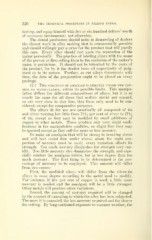Page 652 - My FlipBook
P. 652
:
320 THE TECHNICAL PROCEDURES IN FILLING TEETH.
testing, and equip himself with five or sis hundred dollars' worth
of necessary instruments ; not otherwise.
The dental profession should unite in demanding of dealers
the closest work in alloy making that is commercially possible
and should willingly pay a price for the product that will justify
this care. Every alloy should rest upon the reputation of the
maker personally. The practice of labeling alloys with the name
of the person or finn selling them to the exclusion of the maker's
name, is pernicious. It should not be tolerated by the users of
the product, for by it the dentist loses all opportunity of judg-
ment as to its nature. Further, as cut alloys deteriorate with
time, the date of the preparation ought to be placed on every
package.
(2.) The strength of amalgam is directly under the con-
trol OF MANIPULATION, within its possible limits. This manipu-
lation differs for different compositions of alloys, but it is so
nearly the same for all those that neither shrink nor expand,
or are very close to that line, that these only need to be con-
sidered, except for comparative purposes.
The alloys fit for use are practically all composed of tin
and silver varying but little from 721/0 per cent of silver to 271/2
of tin, except as they may be modified by small additions of
copper or other metals. These produce only very slight modi-
fications in the manipulative qualities, so slight that they may
be ignored except as they call for more or less mercury.
To make an amalgam that will be strong to breaking stress
and will best resist flow under stress, about the right pro-
portion of mercury must be used; every variation affects its
strength. Too much mercury diminishes the strength very rap-
idly. Too little mercury also diminishes the strength, and espe-
cially renders the amalgam brittle, but in less degree than too
much mercury. The first thing to be determined is the per-
centage of mercury to be employed. This amount will differ
from two causes
First, the modified alloys will differ from the silver-tin
alloys in some degree according to the metal used to modify.
For instance, if five per cent of copper is used, a little more
mercury is needed and the amalgam will be a little stronger.
Other metals will produce other variations.
Second, the amount of mercuiy required will be changed
by the amount of annealing to which the alloy has been subjected.
The more it is annealed, the less mercury required and the slower
the setting. By long continued exposure to summer weather, the
320 THE TECHNICAL PROCEDURES IN FILLING TEETH.
testing, and equip himself with five or sis hundred dollars' worth
of necessary instruments ; not otherwise.
The dental profession should unite in demanding of dealers
the closest work in alloy making that is commercially possible
and should willingly pay a price for the product that will justify
this care. Every alloy should rest upon the reputation of the
maker personally. The practice of labeling alloys with the name
of the person or finn selling them to the exclusion of the maker's
name, is pernicious. It should not be tolerated by the users of
the product, for by it the dentist loses all opportunity of judg-
ment as to its nature. Further, as cut alloys deteriorate with
time, the date of the preparation ought to be placed on every
package.
(2.) The strength of amalgam is directly under the con-
trol OF MANIPULATION, within its possible limits. This manipu-
lation differs for different compositions of alloys, but it is so
nearly the same for all those that neither shrink nor expand,
or are very close to that line, that these only need to be con-
sidered, except for comparative purposes.
The alloys fit for use are practically all composed of tin
and silver varying but little from 721/0 per cent of silver to 271/2
of tin, except as they may be modified by small additions of
copper or other metals. These produce only very slight modi-
fications in the manipulative qualities, so slight that they may
be ignored except as they call for more or less mercury.
To make an amalgam that will be strong to breaking stress
and will best resist flow under stress, about the right pro-
portion of mercury must be used; every variation affects its
strength. Too much mercury diminishes the strength very rap-
idly. Too little mercury also diminishes the strength, and espe-
cially renders the amalgam brittle, but in less degree than too
much mercury. The first thing to be determined is the per-
centage of mercury to be employed. This amount will differ
from two causes
First, the modified alloys will differ from the silver-tin
alloys in some degree according to the metal used to modify.
For instance, if five per cent of copper is used, a little more
mercury is needed and the amalgam will be a little stronger.
Other metals will produce other variations.
Second, the amount of mercuiy required will be changed
by the amount of annealing to which the alloy has been subjected.
The more it is annealed, the less mercury required and the slower
the setting. By long continued exposure to summer weather, the


